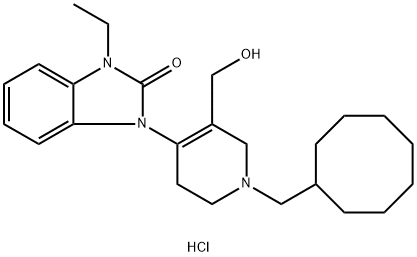1216621-00-9
 1216621-00-9 結(jié)構(gòu)式
1216621-00-9 結(jié)構(gòu)式
基本信息
TRAP-101鹽酸鹽
Trap-101 hydrochloride >=98% (HPLC), powder
1-[1-(cyclooctylmethyl)-5-(hydroxymethyl)-3,6-dihydro-2H-pyridin-4-yl]-3-ethylbenzimidazol-2-one:hydrochloride
1-(1-(cyclooctylMethyl)-5-(hydroxyMethyl)-1,2,3,6-tetrahydropyridin-4-yl)-3-ethyl-1H-benzo[d]iMidazol-2(3H)-one hydrochloride
常見問題列表
pKi: 8.65 (NOP receptor); 6.60 (μ-opioid receptor); 6.14 (κ-opioid receptor); < 5?(δ-opioid receptor)
Trap-101 hydrochloride (3, 30, and 300 nM) is inactive per se up to 10 μM, while in the range 3-300 nM, it produces a concentration dependent rightward shift of the concentration-response curve to N/OFQ without modifications of the maximal response to the agonist. Receptor binding affinities of Trap101 (pK i values) at recombinant human NOP, and classical opioid receptors expressed in CHO cell membranes are 8.65, 6.60, 6.14 and < 5 for NOP,?μ-,?κ-, and?δ-opioid receptors respectively.
Trap-101 hydrochloride (10-30 mg/kg; detected after 90 min) changes motor activity in na?ve rats, it causes a delayed increase in the immobility time in the bar test at 30 mg/kg, Moreover, it increased stepping activity and rotarod performance at 10 mg/kg and reduces them at 30 mg/kg.6-OHDA lesioning produces motor asymmetry mostly affecting the contralateral paw and overall reduced motor performance. Trap-101 hydrochloride (intraperitoneal?injection; 10-30 mg/kg; detected after 90 min) alleviates akinesia/bradykinesia and improves overall gait ability in hemiparkinsonian rats, being effective starting at 1 mg/kg and without worsening motor deficit at 30 mg/kg.
| Animal Model: | 6-OHDA hemilesioned rats |
| Dosage: | 10-30 mg/kg |
| Administration: | Intraperitoneal?injection; 10-30 mg/kg; detected after 90 min |
| Result: | Attenuated parkinsonian-like motor deficits in rat. |
